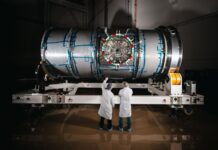NASA, Northrop Grumman, and SpaceX Set to Launch Vital Supplies to the International Space Station
NASA, in collaboration with Northrop Grumman and SpaceX, is preparing for a significant mission to deliver essential science investigations, supplies, and equipment to the International Space Station (ISS). The launch is scheduled for 11:28 a.m. EDT on Saturday, August 3. This mission marks the 21st commercial resupply services mission by Northrop Grumman to the ISS, signifying a continued commitment to supporting the orbital laboratory’s operations.
Live Coverage and Accessibility
NASA will provide comprehensive live coverage of the launch starting at 11:10 a.m. EDT. Viewers can tune in via multiple platforms including NASA+, NASA Television, the NASA app, YouTube, and the agency’s official website. For those unfamiliar with streaming NASA TV, the agency offers detailed instructions on how to access the content across various platforms, ensuring that everyone can stay informed and engaged.
The Cygnus Spacecraft and Its Payload
The mission will see the Northrop Grumman Cygnus spacecraft, loaded with nearly 8,200 pounds of supplies, launched aboard a SpaceX Falcon 9 rocket. The launch will take place from Space Launch Complex 40 at Cape Canaveral Space Force Station in Florida. This payload is crucial for ongoing scientific research and daily operations aboard the ISS.
Arrival and Installation
The Cygnus spacecraft is expected to arrive at the ISS on Monday, August 5. NASA will begin live coverage of the arrival at 2:30 a.m. EDT. The spacecraft will be captured by NASA astronaut Matthew Dominick using the station’s robotic arm, with NASA astronaut Jeanette Epps serving as backup. Following the capture, Cygnus will be installed on the Unity module’s Earth-facing port.
Key Research and Experiments
The Cygnus spacecraft is delivering several noteworthy research projects to the ISS, which include:
- Liquid and Gas Flow Studies: Test articles will be used to evaluate how liquids and gases flow through porous media in the space station’s life support systems.
- STEMonstration on Centripetal Force: A balloon, penny, and hexnut will be used for a new STEM demonstration to illustrate the principles of centripetal force.
- Rotifer Experiments: These microorganisms will help scientists study the effects of spaceflight on DNA repair mechanisms.
- Bioreactor for Stem Cells: A bioreactor will demonstrate the production of high-quality blood and immune stem cells.
- Vascularized Liver Tissue: This project aims to analyze the development of blood vessels in engineered tissue flown to the space station.
Educational Initiatives
NASA’s CubeSat Launch Initiative is also part of this mission, sending two CubeSats to be deployed from the ISS. These include CySat-1 from Iowa State University and DORA (Deployable Optical Receiver Aperture) from Arizona State University. This initiative, known as ELaNa 52 (Educational Launch of Nanosatellites), supports educational institutions in launching small satellite projects.
Media and Public Engagement
For media professionals interested in speaking with a science subject matter expert, Sandra Jones is the point of contact and can be reached via email. Additionally, the public can virtually attend the launch by registering through NASA’s virtual guest program, which provides curated resources, notifications, and a virtual guest passport stamp following the launch.
Mission Timeline and Coverage
Here’s a detailed timeline for the mission coverage (all times in Eastern Daylight Time and subject to change):
Friday, August 2:
- 3 p.m.: Prelaunch media teleconference with key participants from NASA, Northrop Grumman, and SpaceX. Media must request dial-in information by 1 p.m. EDT on August 2.
Saturday, August 3:
- 11:10 a.m.: Launch coverage begins on NASA+, NASA Television, the NASA app, YouTube, and NASA’s website.
- 11:28 a.m.: Official launch time.
Additional Information
For those interested in following the mission in real-time, NASA offers live streaming and blog updates on their website. Photos and on-demand streaming video will be available shortly after liftoff. For further inquiries about countdown coverage, the NASA Kennedy newsroom can be contacted.
Social Media Engagement
NASA encourages the public to engage with the mission on social media platforms such as X (formerly Twitter), Facebook, and Instagram by following and tagging relevant accounts. These include @NASA, @NASAKennedy, @NASASocial, @Space_Station, and @ISS_Research.
Spanish Language Coverage
NASA also provides coverage in Spanish through their NASA en Español section, available on X, Instagram, Facebook, and YouTube. For Spanish-language interviews and additional information, Antonia Jaramillo and Messod Bendayan are the contacts.
Conclusion
The upcoming mission by NASA, Northrop Grumman, and SpaceX represents a significant step in supporting the International Space Station’s scientific endeavors and daily operations. By delivering critical supplies and facilitating groundbreaking research, this mission underscores the importance of international collaboration and continuous innovation in space exploration.
Stay tuned for more updates and engage with the mission through NASA’s various platforms and social media channels. For more detailed information about the commercial resupply mission, visit NASA’s official website.
—
For any media inquiries, please contact:
- Claire O’Shea / Josh Finch: Headquarters, Washington at claire.a.o’shea@nasa.gov / joshua.a.finch@nasa.gov
- Stephanie Plucinsky / Steven Siceloff: Kennedy Space Center, Florida at stephanie.n.plucinsky@nasa.gov / steven.p.siceloff@nasa.gov
- Sandra Jones: Johnson Space Center, Houston at sandra.p.jones@nasa.gov
- Laura Keefe: Northrop Grumman, Cygnus at laura.keefe@ngc.com
For additional resources and updates, visit NASA’s official website.
- 3 p.m.: Prelaunch media teleconference with key participants from NASA, Northrop Grumman, and SpaceX. Media must request dial-in information by 1 p.m. EDT on August 2.
For more Information, Refer to this article.

































